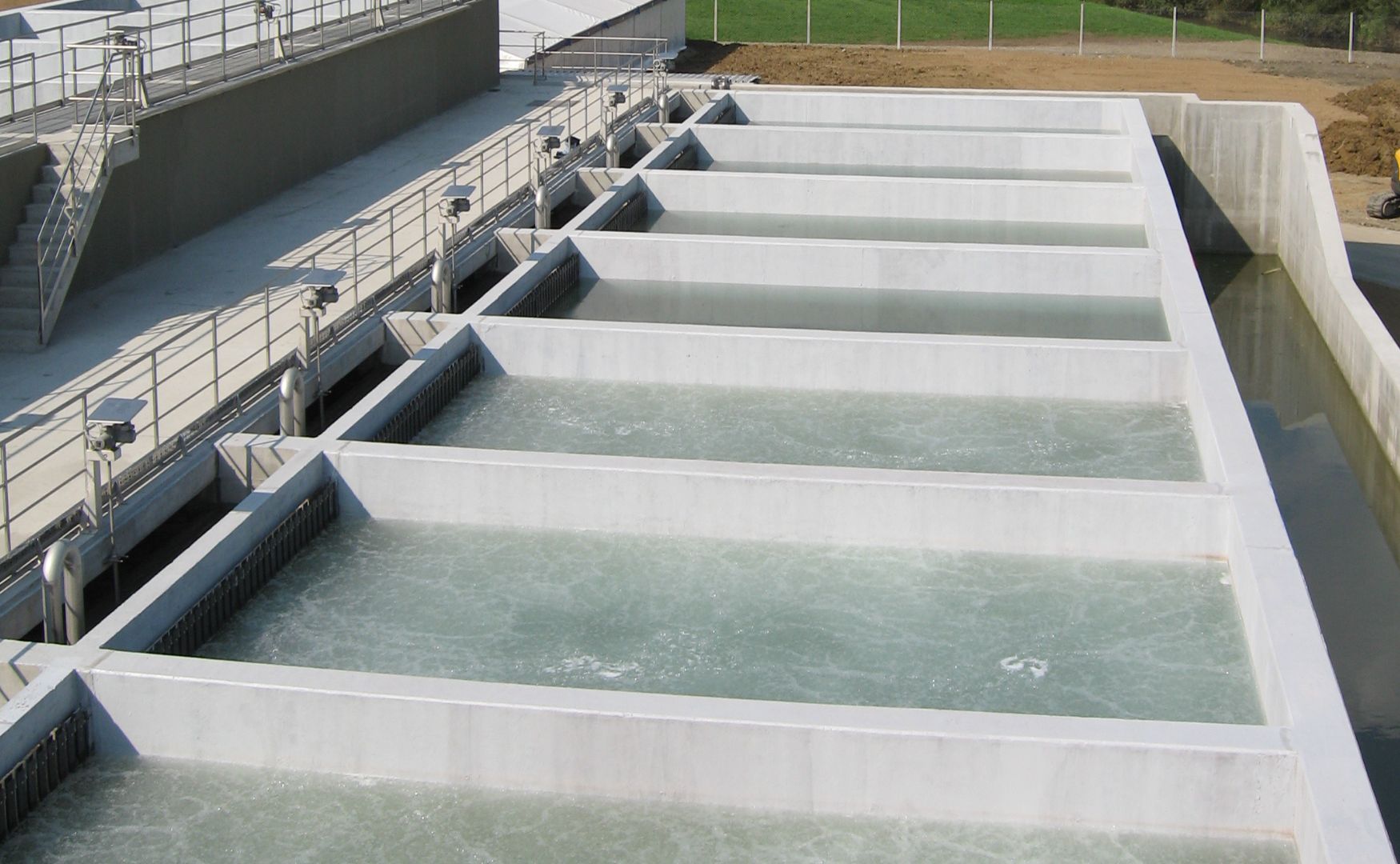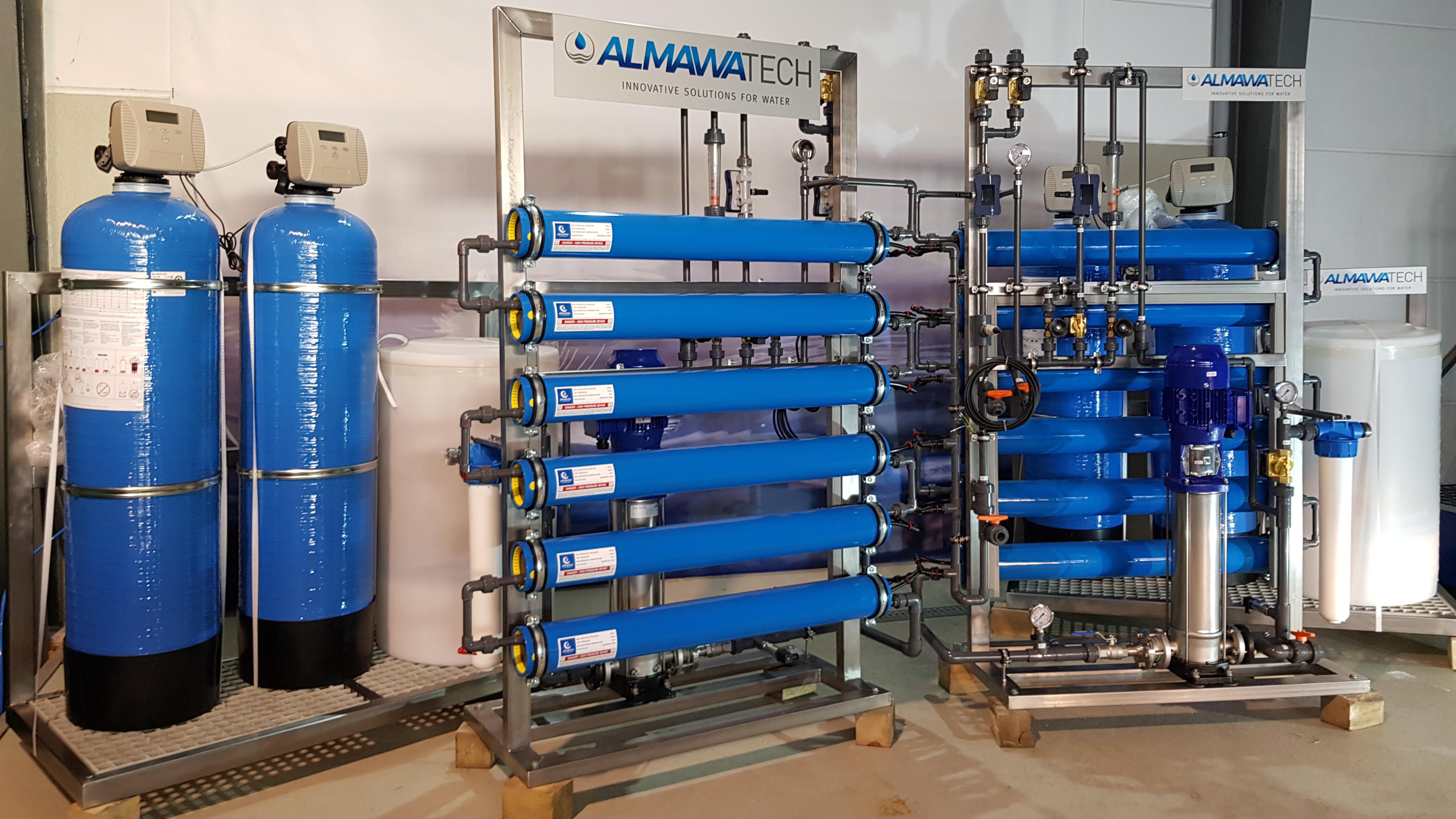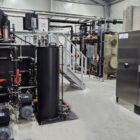Ammonium (NH₄⁺) is a positively charged ionic compound (cation) that is formed from ammonia (NH₃) by reaction with water. It plays a central role in the nitrogen cycle and is an important parameter in industrial water and wastewater treatment, particularly in the treatment of nitrogenous wastewater. There is an equilibrium between ammonium and ammonia in aqueous solutions, with the pH value and temperature determining which of the two molecules is present in higher concentrations.
Table of contents
Technical background
Ammonium (NH₄⁺) is formed when ammonia (NH₃) is dissolved in water and absorbs a proton (H⁺). The pH value of the water influences the balance between ammonium and ammonia. At a pH value below 7, nitrogen is predominantly present in the form of ammonium, while ammonia dominates at higher pH values. Knowledge of this balance is crucial, as ammonia in higher concentrations is toxic to aquatic organisms and can be volatile, whereas ammonium is far less toxic and more stable.
Significance in water and wastewater treatment
Ammonium is of great importance in water and wastewater technology as it serves as an indicator for nitrogen compounds in water. High ammonium concentrations often indicate organic contamination, low oxygen levels or insufficient biodegradation.
Applications in practice:
Biological wastewater treatment: In nitrification and denitrification, two successive processes in biological wastewater treatment, ammonium is converted into nitrite (NO₂-) and then into nitrate (NO₃-). These processes are crucial for removing nitrogen compounds from wastewater and ensuring compliance with legal limits.
Nitrification: The first step in nitrogen removal is nitrification, in which ammonium is oxidized to nitrite and then to nitrate under aerobic conditions by nitrifying bacteria. This step is particularly important in industrial and municipal wastewater treatment plants as it prepares nitrogen for denitrification.
Denitrification: The second step of nitrogen removal takes place under anaerobic conditions, where nitrate is reduced by denitrifying bacteria to nitrogen gas (N₂), which escapes into the atmosphere. Without the preliminary stage of nitrification, in which ammonium is converted into nitrate, the nitrogen could not be removed efficiently.
Anaerobic treatment processes: In anaerobic biogas plants, ammonium is released as a product of the decomposition of organic material. Here, the ammonium concentration is often higher and downstream nitrification or ammonia stripping may be necessary to prepare the wastewater for discharge into water bodies.
- Ammonium in cooling water circuits: Ammonium can be used as an anti-corrosion agent in cooling water systems, as it protects the material from corrosion in certain concentrations. However, this requires close monitoring, as excess ammonium can affect the water quality.
ALMAWATECH produces high-quality corrosion protection agents and other operating fluids for cooling water applications in Germany. If you would like to learn more about our products and solutions, please click on the following link: ALMA AQUA Cooling Water
Process for ammonium removal
High ammonium concentrations in wastewater pose an environmental problem, as they can lead to eutrophication if they enter bodies of water untreated. Various processes are therefore used to remove ammonium:
1. biological processes
- Nitrification and denitrification: In many industrial and municipal wastewater treatment plants, the activated sludge process (such as the ALMA BHU BIO system) is used, in which microorganisms biodegrade the ammonium. Alternatively, biologically activated filters (see photo) or sequencing batch reactors (SBR) can be used.

Photo: Photo of our biologically activated filtration with denitrification and nitrification(ALMA BHU BAF)
2. physico-chemical processes
- Ammonia stripping: At high ammonium concentrations, the ammonium can be converted into gaseous ammonia by raising the pH value and then expelled by stripping.
- Ion exchange: Special ion exchange resins are used to selectively remove ammonium ions from wastewater. This is particularly useful for low ammonium concentrations and in processes that require very high water purity.
3. membrane process
- Reverse osmosis (see photo) and nanofiltration(product overview: membrane filtration) can be used to remove ammonium, especially when it is important to purify the wastewater very finely or to recycle it in closed water circuits.

Photo: Reverse osmosis system with ion exchange columns for low to medium water flows(ALMA OSMO Process)
Challenges in ammonium removal
- pH dependency: The treatment of ammonium is highly dependent on the pH value, as the balance between ammonium and ammonia can be shifted. This requires precise pH regulation to ensure effective ammonium removal.
- Energy and costs: Ammonium removal, especially by physico-chemical processes, can cause high energy consumption and costs, especially with large quantities of wastewater or high ammonium concentrations.
- Residual nitrogen: After biological treatment, residual nitrogen in the form of ammonium can still remain in the wastewater, making it difficult to comply with stricter environmental regulations.
Environmental impact of ammonium
1. eutrophication of water bodies
One of the most serious environmental impacts of ammonium is its role in eutrophication. Eutrophication refers to the over-fertilization of water bodies due to an excessive input of nutrients, especially nitrogen and phosphorus compounds. Ammonium, as a form of reactive nitrogen, contributes significantly to this process. The input of ammonium leads to an increase in the supply of nutrients in the water, which greatly accelerates the growth of algae and other aquatic plants.
Excessive algae growth has several negative consequences:
- Oxygen deficiency: During the decomposition of dead algae, microorganisms consume large amounts of oxygen, which leads to a state of hypoxia (oxygen deficiency) in bodies of water. In extreme cases, this can lead to fish mortality and the death of other aquatic organisms.
- Deterioration of water quality: The massive production of algae can increase the turbidity of the water and worsen the living conditions for many aquatic organisms. The high organic load also promotes the growth of bacteria, which can lead to odor and taste problems in the water.
2. toxicity to aquatic organisms
In certain concentrations and environmental conditions, especially at higher pH values, ammonium can be converted into ammonia (NH₃), which is highly toxic to many aquatic organisms such as fish, invertebrates and algae. Ammonia can enter the bloodstream of fish via their gills and cause toxic effects that lead to nerve damage, behavioral changes and even death.
Even in low concentrations, ammonia can be harmful to aquatic organisms and upset the ecosystem. Larvae and juvenile stages of fish and other aquatic organisms are particularly sensitive to ammonia poisoning.
3. oxygen consumption due to ammonium oxidation
Ammonium itself does not consume oxygen, but the biological conversion of ammonium to nitrate through the process of nitrification leads to a significant consumption of oxygen. The bacteria active in nitrification use oxygen to oxidize ammonium to nitrate. When large amounts of ammonium are discharged into a water body, this biochemical oxygen consumption (BOD) can lead to oxygen depletion, which is life-threatening for fish and other organisms.
4. acidification of water bodies
High ammonium concentrations in bodies of water can also lead to local acidification. Nitric acid (HNO₃) is produced during the biological breakdown of nitrogen through nitrification, which can lower the pH value of the water. This acidification affects many aquatic organisms, as they are often very sensitive to pH fluctuations. A low pH value can jeopardize the survival of fish species and invertebrates that thrive better in more alkaline environments.
5. long-term nitrogen pollution
Another problem of ammonium in the environment is the long-term accumulation of nitrogen in soils and water bodies. If ammonium is not completely removed or degraded, it can accumulate in the environment and enter groundwater sources. This poses a particular risk to drinking water quality, as high nitrate levels in drinking water are harmful to health, especially for infants (methemoglobinemia).
Limit values and monitoring
In industrial and municipal wastewater treatment, strict limits apply to the ammonium nitrogen content in treated wastewater. These limit values vary depending on the region and water protection directive, for example, they are regulated by the EU Water Framework Directive and the German Wastewater Ordinance (AbwV). Continuous monitoring of ammonium nitrogen in wastewater is necessary to ensure compliance with these limits and prevent environmental damage.
Conclusion
Ammonium is an important part of the nitrogen cycle and plays a central role in water and wastewater treatment. The correct handling and removal of ammonium is crucial to minimize environmental pollution and ensure water quality. Various biological, physico-chemical and membrane-based processes are available to efficiently remove ammonium from industrial and municipal wastewater. Precise control of pH value, temperature and operating parameters is essential to achieve optimum removal.








